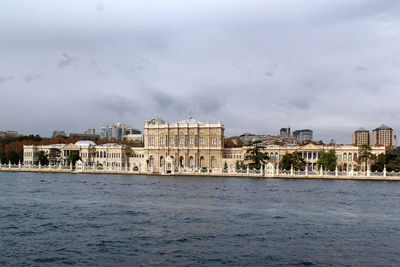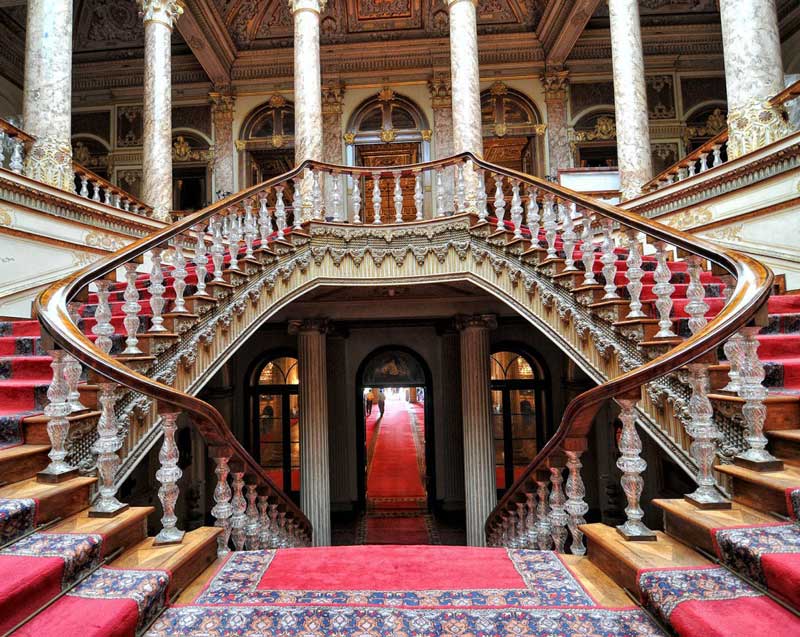
Located in Istanbul, Turkey, on the European side of the Bosphorus Strait, the Dolmabahçe Palace, Turkey’s largest mono-block palace, was commissioned by Sultan Abdül Mecit in 1843 and served as a residential quarter and administration centre of the Ottoman Empire from 1856 to 1887 and from 1909 to 1922. Before its construction, the Sultan and his family had lived at the Topkapi Palace. But as the medieval Topkapi Palace lacked the contemporary style, luxury and comforts devoured by the European monarchs, Sultan AbdülMecit I decided to move his imperial court from Topkapı to a lavish new palace on the shores of the Bosphorus, adjacent to the site of the former BeşiktaşSahil Palace, which was demolished.
The Sultan intended to construct a new richly decorated Ottoman-European Palace on that site, departing from the traditional Ottoman style of constructing a series of pavilions, to impress the world.

To materialise his dream project, he commissioned the leading Ottoman architect Garabet Baylan and his son Nigoğayos to build a mono-block Ottoman-European Palace, while Charles Garnier, the designer of the Paris Opera, was hired to take care of the interiors. The construction work of the project began in 1843 and was finished in 1856, but the sultan and his family moved in two years later.
Although the construction of the Dolmabahçe Palace was intended to cover up the fact that the Ottoman Empire was in decline, the extravagant project precipitated the empire’s bankruptcy and indicated the signal of the beginning of the end for the Osmanlı dynasty. The huge construction cost of a staggering five million Ottoman gold coins, which corresponded to approximately a quarter of the annual tax revenue, placed an enormous burden on the royal treasury and contributed to the massive crumbling financial situation of the Ottoman Empire. Eventually, it paved the way for the establishment of financial control over the country by the European powers in 1881, depicting Turkey as the sick man of Europe.

Nevertheless, since its inception as the administrative centre of the Ottoman Empire in 1856, the Dolmabahçe Palace was home to six Sultans, until the abolishment of the caliphate in 1924, except for an interval of 20 years, from 1889 to 1909, when the Yıldız Palace was used as the Royal Palace. After the proclamation of the Republic of Turkey on 29 October 1923, the ownership of the palace was shifted to the National Heritage of the new Republic on 3rd March 1924.
Although Mustafa Kemal Atatürk, the founder of the Turkish Republic, used the palace as a presidential house only in the summer, troubled by health problems, he spent his last years in the palace. He died in the palace on 10 November 1938, at 09: 05 in the morning, when all the clocks in the palace were manually stopped in his honour
Originally, the area in which the Dolmabahçe Palace now stands, was a small bay of the Bosphorus, which was used for the anchorage of the Ottoman fleet. Gradually, the area was reclaimed from the 18th century onwards to become an imperial garden by the Bosphorus. The garden, very much appreciated by the Ottoman Sultans, was named Dolmabahçe, which literally stands for the filled-in garden. During the 18th and 19th centuries, several small summer palaces and wooden pavilions were built in the area, which eventually formed a palace complex named Beşiktaş Waterfront Palace. Finally, the mono-block Dolmabahçe Palace, covering an area of 11.1 acres (45,000 square metres), was constructed in the area, with the garden surrounding the palace.

The Dolmabahçe Palace, containing 285 rooms, 44 halls, 68 toilets and 6 baths (Hamam), with a ceiling, decorated with gold leaves made of 14 tons of gold and the floor, covered with 131 handmade silk carpets, was constructed in a new synthesis of architectural style. With certain key elements of the Baroque, Rococo and Neoclassical styles, blended with traditional Ottoman architecture, the palace reflects the increasing influence of European styles on traditional Ottoman art and culture. But functionally, it strictly followed the traditional Ottoman custom of maintaining privacy and structurally separated the southern wing, also known as Selamlık or Mabeyn and the northern wing or the Harem. While the Selamlık, containing the public representation rooms, were reserved for the men, the Harem served as the private residential area for the Sultan and his family. The two functional parts are separated by a huge Ceremonial Hall or Muayede Salonu. Covering more than 2000 square metres (roughly 21,600 square feet) area and adorned with 56 majestic columns, Muayede Salonu is the most magnificent section of Dolmabahce Palace and is distinguished from other halls of the Palace with its 118 feet (36 m) high dome and a 4.5 tons British made crystal chandelier, consisting of 750 bulbs and weighs a massive 4 tons, gifted by Queen Victoria of England. Following the traditional customary concept to keep the Harem completely isolated from the outside world, the main entrance for the visitors was arranged on the narrow southern side of the palace, containing the representation rooms for the reception of the visitors and the foreign dignitaries.

The Selamlik or the Mabeyn, located at the front of the palace and reserved for the men, is the most prominent section of the building as the place for official business in Istanbul. Containing ornately furnished reception halls, along with a series of more-intimate salons, it is more impressive than the harem section, where wealth and luxury are displayed. There are also two exhibition halls filled to the brim with precious objects from the palace collections, which include ancient paintings hand-carved artefacts and antique furniture.

Occupying two thirds of Dolmabahce Palace, the Harem section is located at the rear and is connected to Mabeyn and Muayede Hall through corridors with iron gates and heavy timber doors, evidencing traditional segregation. The entire area of the section, containing spacious halls, is lightened by the reflected light of Bosporus and houses the bedrooms of Sultans, his wives, concubines and the children, along with the study and lounge rooms. The interesting and impressive features of Harem are the apartment of the Mother Sultan, the Blue and the Pink Halls, the study and bedroom of Mustafa Kemal Atatürk, the rooms of the concubines and numerous valuable artefacts such as the antique furniture, rugs, vases, chandeliers and oil paintings.

A grand Crystal Stairs lead to the upper floor of the palace, containing the Süfera or the Ambassador’s Hall, the guest room for the ambassadors and also the Red Room, where Sultan received the ambassadors. All the halls are richly decorated and furnished to emphasize the wealth and splendour of the Empire. The Zülvecheyn Hall, also located on the upper floor, allows a crossing to the Sultan’s private living quarters in the Mabeyn section. Apart from study rooms and halls, this section of the palace also contains a magnificent Hamam, opulently furnished with costly marbles from Egypt.

The complex of the Dolmabahce Palace contains several other buildings, including the dormitories of the servants and guards, the quarters of the Chief Eunuch, the leader of the eunuchs guarding the Imperial Harem, along with the VeliahtDairesi, the palace of the Crown Prince, which since 2014 houses the National Palaces Painting Museum. Apart from that, a clock tower, locally known as Dolmabahçe Saat Kulesi, designed by the court architect Sarkis Balyan, was erected between 1890 and 1895, in front of the Imperial Gate of the palace. Unlike the palaces in continental Europe, the Dolmabahce Palace was equipped with the facilities of Gas Lighting and water closets from its inception and later, electricity, a central heating system and an elevator were also installed.